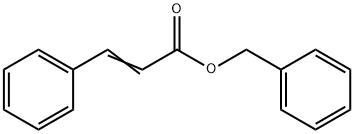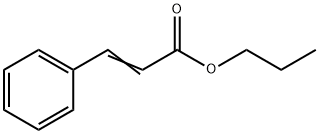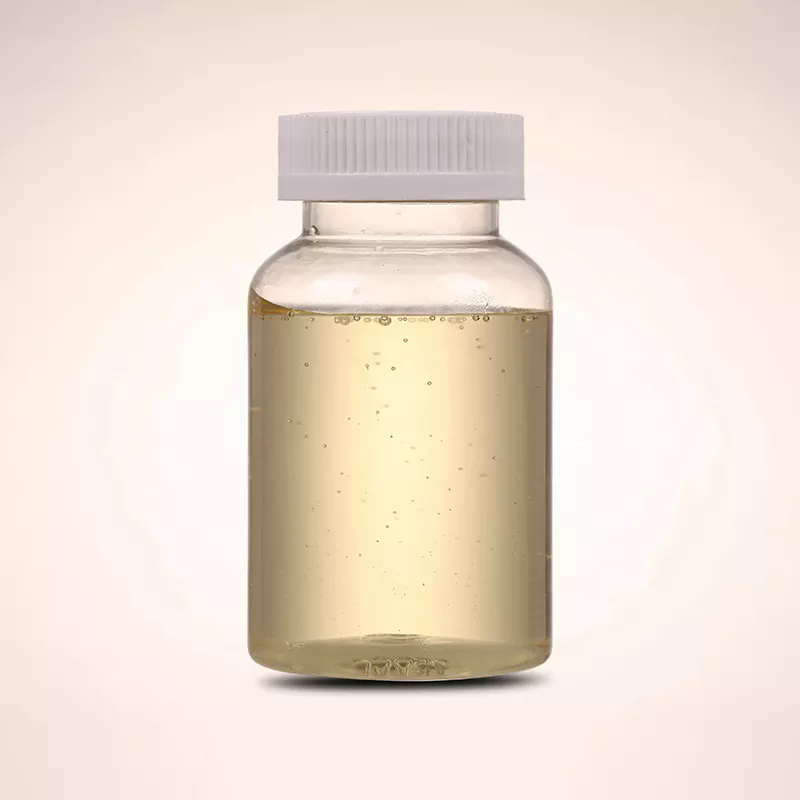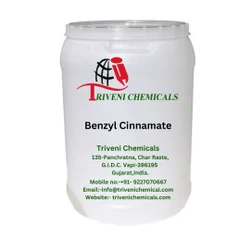Benzyl cinnamate
Synonym(s):3-Phenyl 2-propenoic acid benzyl ester;Benzyl 3-phenylpropenoate;Benzyl cinnamate;Benzyl trans-3-phenylpropenoate;Cinnamic acid benzyl ester
- CAS NO.:103-41-3
- Empirical Formula: C16H14O2
- Molecular Weight: 238.28
- MDL number: MFCD00004789
- EINECS: 203-109-3
- SAFETY DATA SHEET (SDS)
- Update Date: 2025-12-24 08:33:08

What is Benzyl cinnamate?
Chemical properties
Clear colorless to yellowish crystalline mass or liquid after meltin
Chemical properties
Benzyl Cinnamate occurs in balsams and balsam oils. It forms white, sweet-balsamic-smelling crystals (mp 35-36°C). Benzyl cinnamate is used as a fixative in perfumes and as a component of heavy, oriental perfumes.
Chemical properties
Benzyl cinnamate has a sweet, balsamic odor and a honey-like taste.
Occurrence
Reported found in Peru and Tolu balsam, in Sumatra and Penang benzoin, and as the main constituent of copaiba balsam.
The Uses of Benzyl cinnamate
Benzyl cinnamate has been employed as internal standard during the determination of compounds commonly added to personal care products such as UV filters and antimicrobial agents in environmental samples.
The Uses of Benzyl cinnamate
Mild. sweet-balsamic and somewhat floral
odor of great tenacity. Used quite frequently in perfumery, mainly
as a fixative, and particularly in perfumes for Talcum (powders). It blends well with floral
bases, spicy fragrances and Ambre types.
Used in flavor compositions for imitation
Apricot, Cherry, Chocolate, Honey, Peach,
Pineapple, Liquor, Raspberry, Rum, Prune,
etc.
Concentration may be little more than
traces, usually about 6 ppm, except in chewing
gum: up to 125 ppm.
Preparation
By heating benzyl chloride and excess sodium cinnamate in water to 100 to 115°C; by heating sodium cinnamate with an excess of benzyl chloride in the presence of diethylamine.
Production Methods
Benzyl cinnamate is produced by the direct esterification of benzyl alcohol with cinnamic acid.
Definition
ChEBI: Benzyl cinnamate is the cinnamate ester derived from cinnamic acid and benzyl alcohol. Occuring in Balsam of Peru and Tolu balsam, in Sumatra and Penang benzoin, and as the main constituent of copaiba balsam, it is used in heavy oriental perfumes, as a fixative and as a flavouring agent. It has a role as a flavouring agent, a fragrance, a fixative, an antigen and an epitope.
Taste threshold values
Taste characteristics at 50 ppm: spicy, floral, fruity, balsamic.
General Description
Benzyl cinnamate is widely used as a fragrance ingredient.
Hazard
Moderately toxic.
Flammability and Explosibility
Non flammable
Safety Profile
Moderately toxic by ingestion. Amild allergen and skin irritant. Combustible liquid. When heated to decomposition it emits acridsmoke and irritating fumes.
Metabolism
See monograph on Benzyl alcohol (p. 1011).
Purification Methods
Recrystallise the ester to a constant melting point from 95% EtOH. It has the odour of balsam. Alternatively dissolve it in Et2O, wash it with 10% aqueous Na2CO3, H2O, dry (Na2SO4), evaporate and fractionate it under reduced pressure using a short Vigreux column (p 11). It decomposes when boiled at atmospheric pressure. [Eliel & Anderson J Am Chem Soc 74 547 1952, Bender & Zerner J Am Chem Soc 84 2550 1962, Beilstein 9 IV 2012.]
Properties of Benzyl cinnamate
| Melting point: | 34-37 °C (lit.) |
| Boiling point: | 195-200 °C/5 mmHg (lit.) |
| Density | 1.11 |
| vapor pressure | <0.1 hPa (20 °C) |
| FEMA | 2142 | BENZYL CINNAMATE |
| refractive index | 1.4025-1.4045 |
| Flash point: | >230 °F |
| storage temp. | Store below +30°C. |
| solubility | alcohol: soluble(lit.) |
| form | Crystalline Mass or Liquid After Melting |
| color | Clear colorless to yellow |
| Odor | aromatic odor |
| Water Solubility | PRACTICALLY INSOLUBLE |
| Merck | 14,1130 |
| JECFA Number | 670 |
| BRN | 2051339 |
| CAS DataBase Reference | 103-41-3(CAS DataBase Reference) |
| NIST Chemistry Reference | Benzyl cinnamate(103-41-3) |
| EPA Substance Registry System | Benzyl cinnamate (103-41-3) |
Safety information for Benzyl cinnamate
| Signal word | Warning |
| Pictogram(s) |
 Exclamation Mark Irritant GHS07  Environment GHS09 |
| GHS Hazard Statements |
H317:Sensitisation, Skin H410:Hazardous to the aquatic environment, long-term hazard |
| Precautionary Statement Codes |
P261:Avoid breathing dust/fume/gas/mist/vapours/spray. P272:Contaminated work clothing should not be allowed out of the workplace. P273:Avoid release to the environment. P280:Wear protective gloves/protective clothing/eye protection/face protection. P302+P352:IF ON SKIN: wash with plenty of soap and water. P333+P313:IF SKIN irritation or rash occurs: Get medical advice/attention. |
Computed Descriptors for Benzyl cinnamate
Benzyl cinnamate manufacturer
New Products
4,4-Difluoropiperidine hydrochloride tert-butyl 9-methoxy-3-azaspiro[5.5]undecane-3-carboxylate Indole Methyl Resin N-Isopropylurea N,N-Dicyclohexylcarbodiimide(DCC) MELDRUMS ACID 5-METHYLISOXAZOLE-4-CARBOXYLIC ACID Magnessium Bis glycinate Zinc ascorbate 1-bromo-2-butyne 2-acetamidophenol 9(10H)-anthracenone Erythrosin B, 4-Piperidinopiperidine 2-((4-morpholinophenylamino) (methylthio) methylene) malononitrile 2,4-dihydroxybenzaldehyde 3-(4-morpholinophenylamino)-5-amino-1H-pyrazole-4-carbonitrile Methyl 2-methylquinoline-6-carboxylate 2,6-dichloro-4-nitropyridine 4-Bromo-2-chlorobenzonitrile 2-(benzylamino)acetic acid hydrochloride 4-(tert-Butoxycarbonylamino)but- 2-ynoic acid 3,4-dihydro-2H-benzo[b][1,4]dioxepine 1-Phenyl-1-cycloprppanecarboxylicacidRelated products of tetrahydrofuran





![(aR)-alpha-[(1S)-1-[2,6-Dimethoxy-4-(2-propen-1-yl)phenoxy]ethyl]-4-hydroxy-3-methoxybenzenemethanol](https://img.chemicalbook.in/CAS/GIF/171485-39-5.gif)


You may like
-
 103-41-3 Benzyl cinnamate 98%View Details
103-41-3 Benzyl cinnamate 98%View Details
103-41-3 -
 Benzyl cinnamate 98.00% CAS 103-41-3View Details
Benzyl cinnamate 98.00% CAS 103-41-3View Details
103-41-3 -
 Benzyl Cinnamate CAS 103-41-3View Details
Benzyl Cinnamate CAS 103-41-3View Details
103-41-3 -
 Benzyl cinnamate CAS 103-41-3View Details
Benzyl cinnamate CAS 103-41-3View Details
103-41-3 -
 Benzyl cinnamate CAS 103-41-3View Details
Benzyl cinnamate CAS 103-41-3View Details
103-41-3 -
 Benzyl cinnamate CAS 103-41-3View Details
Benzyl cinnamate CAS 103-41-3View Details
103-41-3 -
 Benzyl Cinnamate .View Details
Benzyl Cinnamate .View Details
103-41-3 -
 98% Min Benzyl Cinnamate, Packaging Size: DrumView Details
98% Min Benzyl Cinnamate, Packaging Size: DrumView Details
103-41-3
